
.
If you have any comments, observations, or questions about what you read here, remember you can always Contact Me
All content included on this site such as text, graphics and images is protected by U.S and international copyright law.
The compilation of all content on this site is the exclusive property of the site copyright holder.
The first exit on the Henry Hudson Parkway northbound after getting off the George Washington Bridge and onto the highway is Ft. Tryon Park and The Cloisters. Every time, I'd think to myself, "I really must go there." Today I did. And while I'm sorry I didn't do so before it's clear my next visit will not have so long a delay. "What," you might ask, "are The Cloisters?" A branch of The Metropolitan Museum of Art, it is a special place with a focus on the art and architecture of medieval Europe. Think again if "museum" makes you think of rectangular rooms and long hallways stuffed with paintings and statuary. What sets The Cloisters apart and makes it so unique, so unlike what you may have seen before, is the structure itself. Set on a hilltop with commanding views of the Hudson River

assembled from architectural elements from the medieval period, twelfth to fifteenth century - elements from five medieval French cloisters and from other monastic sites in southern France, an apse from the church of San Martin at Fueniduena in Spain and more - creating a spirit of place that makes The Cloisters a unique setting for the paintings and statuary and objects of the period. There are four cloisters, three of which contain gardens. Come, join me as - museum map in hand with its useful descriptions - we explore.
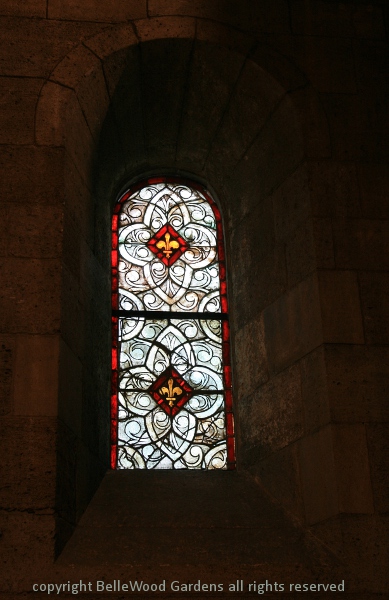
Brighter within than when viewed from outside, as you might expect there's the churchly aspect of stained glass windows, illuminated as light streams through the glass. I find the intricate lacework pattern of the lead came on this window very pleasing, embellished as it is with only modest amounts of scarlet and gold glass.

The walls are massive, built of great stone blocks.

I followed not an orderly path but wander through a maze of spaces, coming to Saint Guilhem Cloister. This is the one of the four cloisters that has not a garden but instead potted plants. Brought from a monastery near Montpellier, filled with light which details the fine carving , acanthus and palm, the very plants growing in pots nearby the small fountain, the cloister's space is serene, very calm and peaceful.

Another magical place, the Pontaut Chapter House was once the meeting place for monks of the Cistercian abbey at Pontaut, in Aquitaine. That was in the 12th century. By the time it was purchased in the 1930s, the columns were being used to tether farm animals.
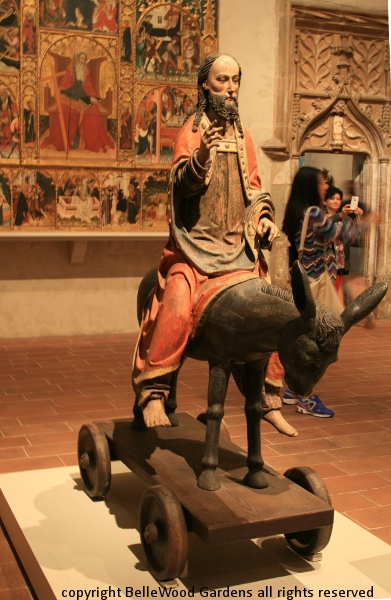
Speaking of farm animals, here's a Palmesel, a palm donkey. The term refers to Christ's entry into Jerusalem, mounted on a donkey. The palmesel would have been part of a Palm Sunday procession, popular in many German-speaking regions up until the Reformation.
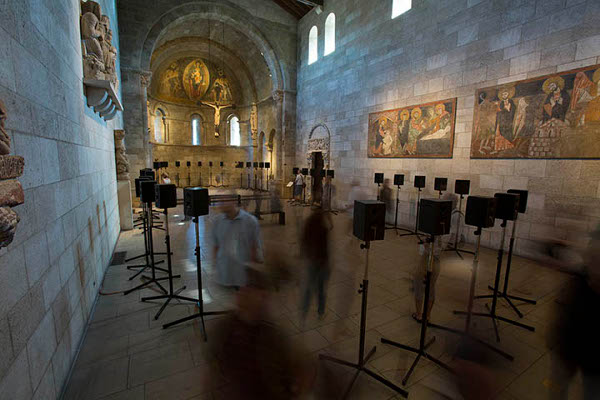
image copyright The Metropolitan Museum of Art, New York
There's an additional inducement, above and beyond the fact that it's about time for this visit. I read an article about the Forty Part Motet, a 16th century motet by Thomas Tallis, Spem in alium numquam habui. Difficult to briefly explain but I'll try. It's human voices, 40 of them. Each recorded separately by Janet Cardiff, each now played back through 40 separate speakers. Bass, baritone, tenor, alto, child soprano, in chorus and individually. Stand in the center of the 12th century Fuentiduena Chapel, a large oval circumscribed by the speakers, black boxes up on stands, as the sound washes through you. Transcendent is the right word. Not just my take on this either. A bearded man, head shaved, looking like someone from Breaking Bad was standing in an angle of the wall, arms crossed over his chest, eyes closed. A 20 something couple, his arms around her and her head bowed, resting on his shoulder. The cycle is 12 minutes, a pause, it cycles again. I listened twice, and came back again before leaving to go home.

Christ, crucified, hangs over us.
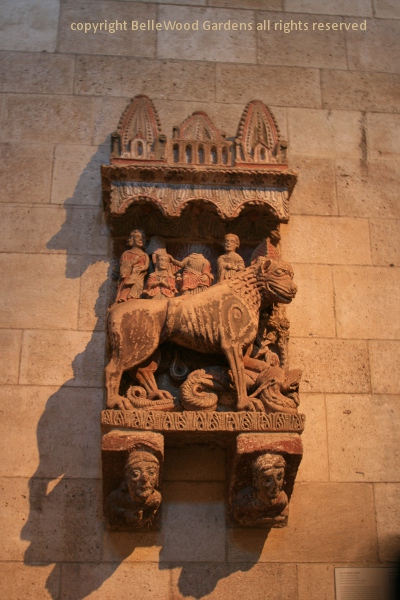
Here the lion tramples the serpent of evil, another piece of statuary in the chapel. Believing that lions come to life not at birth but three days later, the analogy is to the resurrection.

Today is Garden Day at The Cloisters, with special lectures celebrating the 75th anniversary of The Cloister's opening. A cloister, by the by, is an open courtyard with a colonnade, a covered walkway surrounding it. The building surrounds the cloister and its colonnades so while open, it is enclosed. A formally designed garden with raised beds separated by crossing pathways, a sundial or fountain at their midpoint. Fruit trees, herbs, perennials, make a cloister a calm and attractive space. This is the Cuxa Cloister and its garden.
The twelfth-century Cuxa Cloister was part of a large Benedictine monastery in the northeast Pyrenees. The French Romanesque garden features the traditional crossed paths that form quadrants with four perennial borders. Medieval in its design, the Cuxa Cloister contains modern species along with medieval plants to assure an extended, diverse flowering season.
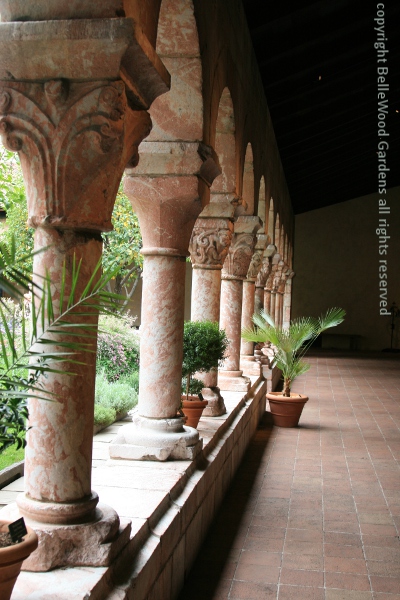
Not entirely the original material, a sign illustrates which portions of the columns are restored. The pink stone of the originals was quarried in the 12th century in the Pyrenees mountains for a nearby Benedictine monastery.

.

A rosemary is just one of the fragrant potted plants set on the low wall. It's my understanding that in winter the arcades are enclosed and the potted plants embellish the walkways.
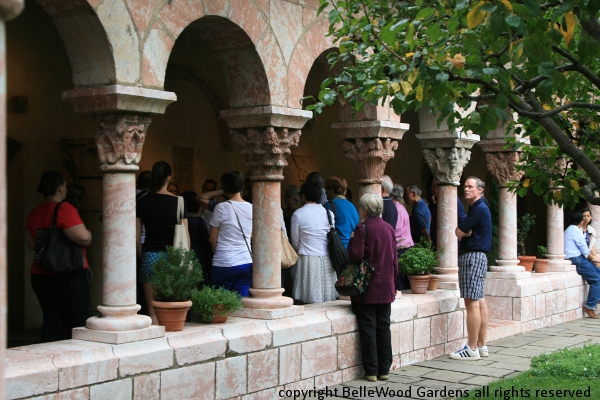
Gardening as it featured in medieval times are a feature of the day's lectures. This audience is listening to a tour of The Cloisters gardens, a movable event that goes from place to place. Some of the plants, such as Lespedeza thunbergii 'Gibralter', bush clover; Anemone japonica, Japanese anemone; and Platycodon, balloon flower, are modern. Cloister gardens, though, were places where medicinals, dye plants, hops for brewing, and other useful plants were tended.
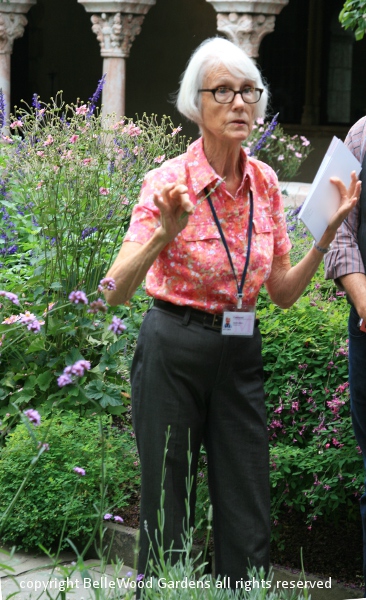
I did have a problem with this presenter, who said that Teucrium, germander, contains colchicine and was used to treat gout. With my passion for bulbs I could not let that pass and stuck up my hand. When asked if I had a question I happily spoke up about Colchicum, a bulb, and the source (even in contemporary times) for colchicine. A few words on both sides and then the presenter said that yes, colchicine also comes from the stamens of the crocus. Sigh. Though colchicum is commonly called the autumn crocus it is not included in that genus. And the drug comes from the bulb. The truly named autumn crocus is Crocus sativus, whose stamens are the source for saffron.No matter, I suppose, as I doubt any of her audience would be preparing colchicine. Didn't even see any colchicum or saffron crocus in flower.
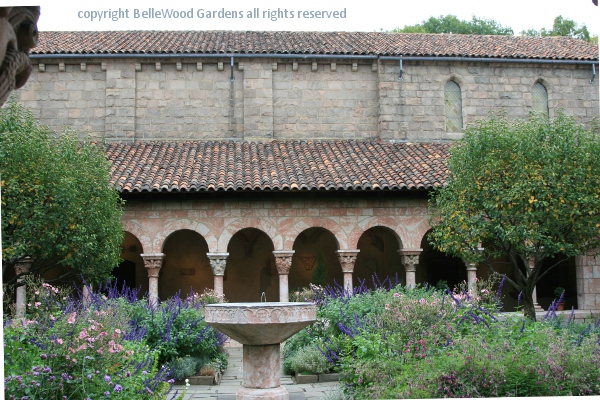
Today in the cloister garden is too fine a day for quibbling. There's more to enjoy, and I shall.
Off I go to the Bonnefont Cloister
Back to Top
Back to October 2013